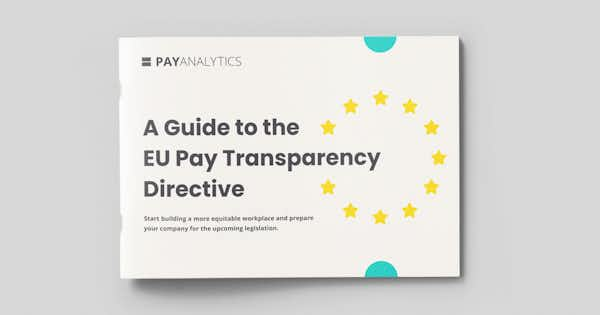Guida alla certificazione della parità di genere in Italia | Scarica il nostro e-book gratuito
How Does PayAnalytics Support the EU Pay Transparency Directive?
This article was last updated on April 16, 2024.
From the time the EU pay transparency directive was only draft legislation, PayAnalytics has been tracking its requirements and making corresponding updates to our software solution. Through expanded capabilities and some new features, we’re helping our clients get compliant and stay compliant with the directive’s analysis, reporting, and pay transparency requirements.

What the directive requires
On March 30, 2023, the European Parliament passed the EU pay transparency directive into law. The directive requires organizations to measure, correct and report on pay gaps within categories of workers, who do the same work or work of equal value to the organization.
If an employer identifies a pay gap of 5% or greater within any group of employees after accounting for objective factors, the employer must take corrective action. They can either correct the gap within six months or create a gender action plan that outlines how they will correct it long-term.
The directive also makes information about pay and pay ranges more available to current employees and job applicants. This information must be provided to job applicants prior to an interview and to employees on request. Other requirements govern employees’ right to discuss pay and prohibit employers from asking candidates about salary history.
For a simple overview of the directive, you may want to check out our pocket guide or listen to our coffee talk podcast episode. You can also get the free e-book to learn about its requirements in more depth and detail.
How we’ve prepared
Before the directive became law in 2023, PayAnalytics carefully reviewed each new draft that moved through the European Parliament. We were invited to provide input into the work of the European Parliament group responsible for reviewing the directive—while at the same time working on updates to our software. We are happy to say that PayAnalytics satisfies the directive’s criteria for pay equity analysis and support for pay transparency and reporting.
We help organizations comply with the directive in two main ways:
1️⃣ Pay equity analysis
On the Compensation Model Results page, PayAnalytics users can view pay gaps by groups based on any grouping in the data. This option covers both the unadjusted and the adjusted pay gaps.We’ve also made it easy to understand where to start and which groups to focus on when addressing the pay gaps in different groups.
And, since early 2023, users have been able to perform pay gap correction within groups. This feature allows organizations to target raises to specific groups of employees, rather than the whole organization. For instance, if a gap is identified among customer service workers, users can view only their customer service workers to see which employees need raises. This makes it easier for companies to fix pay discrepancies and stay compliant with the directive.
2️⃣ Pay transparency
The Directive gives employees and job applicants the right to information about pay ranges and requires employers to report their unadjusted pay gaps, both overall and within each category of workers.
We now offer a built-in report to make this reporting task easy. We need to note, however, that since EU member states are in the process of transposing the directive into national law, the eventual reporting requirements may vary by country. As member states formulate their own laws, we’ll continue to track the country-level requirements and will update the report templates as necessary.
The directive gives employees and job applicants the right to information about pay ranges. PayAnalytics offers employers everything they need to formalize and document pay policies to confidently respond transparently to candidates’ or employees’ requests for compensation information.
There’s a good chance that PayAnalytics can make it easier for your organization. To see for yourself, book a free demo of our software solution.
Le informazioni contenute in questa pagina non intendono fornire né forniscono consulenza legale. Tutti i contenuti, le informazioni e i materiali presenti in questo articolo sono solo per uso informativo generale. Si avvisano i lettori che queste informazioni, legali o di altra natura, potrebbero non essere aggiornate.





